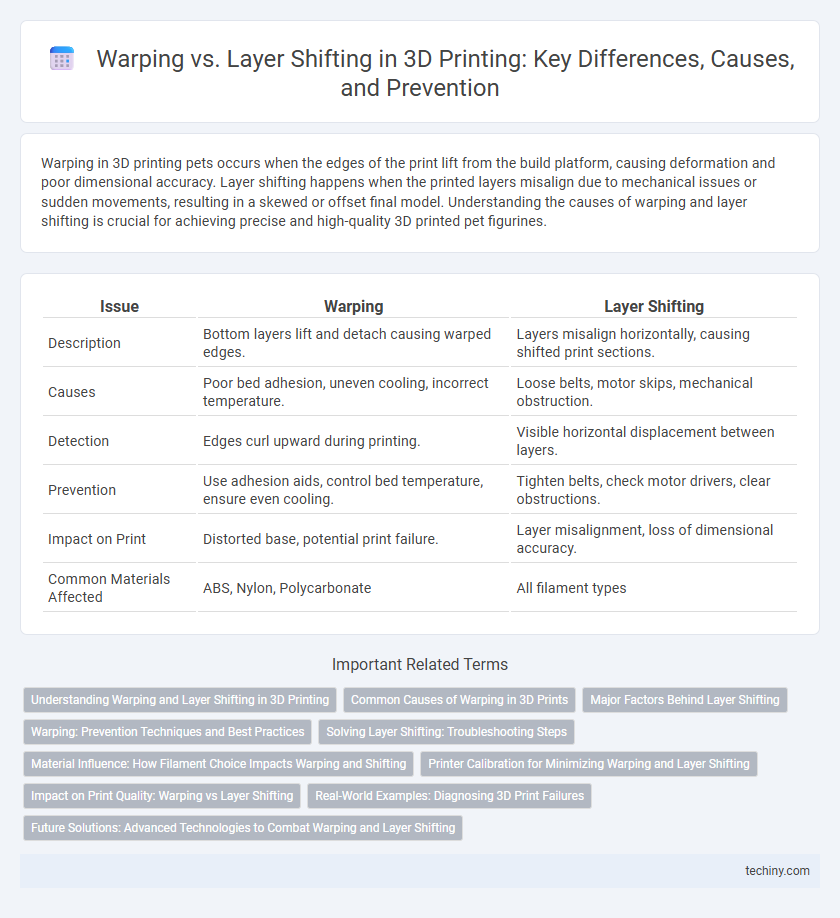Warping in 3D printing pets occurs when the edges of the print lift from the build platform, causing deformation and poor dimensional accuracy. Layer shifting happens when the printed layers misalign due to mechanical issues or sudden movements, resulting in a skewed or offset final model. Understanding the causes of warping and layer shifting is crucial for achieving precise and high-quality 3D printed pet figurines.
Table of Comparison
| Issue | Warping | Layer Shifting |
|---|---|---|
| Description | Bottom layers lift and detach causing warped edges. | Layers misalign horizontally, causing shifted print sections. |
| Causes | Poor bed adhesion, uneven cooling, incorrect temperature. | Loose belts, motor skips, mechanical obstruction. |
| Detection | Edges curl upward during printing. | Visible horizontal displacement between layers. |
| Prevention | Use adhesion aids, control bed temperature, ensure even cooling. | Tighten belts, check motor drivers, clear obstructions. |
| Impact on Print | Distorted base, potential print failure. | Layer misalignment, loss of dimensional accuracy. |
| Common Materials Affected | ABS, Nylon, Polycarbonate | All filament types |
Understanding Warping and Layer Shifting in 3D Printing
Warping in 3D printing occurs when printed layers cool unevenly, causing edges to lift and distort the overall shape, often due to inadequate bed adhesion or temperature fluctuations. Layer shifting happens when the printer's mechanical components misalign, resulting in horizontal displacement of layers and a visibly skewed model. Understanding these issues helps optimize print settings, such as bed temperature, print speed, and mechanical calibration, to achieve accurate and high-quality prints.
Common Causes of Warping in 3D Prints
Warping in 3D printing commonly occurs due to uneven cooling of the printed material, causing the edges to lift away from the print bed. Improper bed adhesion, insufficient heated bed temperature, and rapid temperature changes during the printing process are primary factors leading to warping. Material properties like ABS are more prone to warping compared to PLA, emphasizing the need for controlled environmental conditions.
Major Factors Behind Layer Shifting
Major factors behind layer shifting in 3D printing include mechanical issues such as loose belts, misaligned pulleys, or worn-out stepper motors that cause the print head to skip steps. Sudden impacts or vibrations during printing can also lead to layer misalignment. Incorrect printer settings, like excessively high print speeds or acceleration, further increase the risk of layer shifting.
Warping: Prevention Techniques and Best Practices
Warping in 3D printing occurs when printed layers cool unevenly, causing the edges to lift and deform the model. To prevent warping, maintain a consistent bed temperature between 50-70degC for PLA or 90-110degC for ABS, use a heated enclosure, and apply adhesive surfaces like glue sticks or PEI sheets. Ensuring proper bed leveling and using brim or raft structures also improve adhesion and reduce the risk of warping during the printing process.
Solving Layer Shifting: Troubleshooting Steps
Layer shifting in 3D printing often results from mechanical issues such as loose belts, misaligned pulleys, or inadequate stepper motor current. Tightening belts, verifying pulley alignment, and adjusting stepper motor current settings can resolve most layer shift problems quickly. Regular maintenance of the printer's frame and ensuring smooth movement paths further prevent recurring layer shifts for consistent print quality.
Material Influence: How Filament Choice Impacts Warping and Shifting
Filament choice significantly impacts warping and layer shifting in 3D printing, as materials like ABS tend to contract more during cooling, increasing warping risks compared to PLA. High-temperature filaments, such as Nylon and Polycarbonate, require precise bed adhesion and temperature control to minimize deformation and misalignment between layers. Flexible materials like TPU demand slower print speeds and careful calibration to prevent layer shifting due to their elasticity and extrusion challenges.
Printer Calibration for Minimizing Warping and Layer Shifting
Precise printer calibration is essential for minimizing warping and layer shifting in 3D printing, as accurate bed leveling and extruder alignment ensure consistent filament deposition and adhesion. Proper calibration of stepper motor currents and belt tension maintains smooth and precise movements, reducing mechanical slack that causes layer misalignment. Bed temperature optimization combined with effective use of adhesion aids, such as glue sticks or build plates, further stabilizes prints, preventing warping caused by uneven cooling.
Impact on Print Quality: Warping vs Layer Shifting
Warping causes parts of a 3D print to lift and distort, leading to uneven surfaces and dimensional inaccuracies that compromise overall print quality. Layer shifting results in misaligned layers, producing visibly stepped or skewed prints that disrupt structural integrity and detail precision. Both defects severely impact the final appearance and functionality of 3D printed objects, requiring specific calibration strategies to mitigate.
Real-World Examples: Diagnosing 3D Print Failures
Warping in 3D printing commonly occurs due to uneven cooling, causing corners of a print to lift off the build plate, as seen when printing large ABS parts without a heated bed. Layer shifting often results from mechanical issues like loose belts or stepper motor skips, evident in prints where layers suddenly misalign horizontally, creating a staircase effect. Diagnosing these failures involves inspecting temperature settings and hardware stability, with real-world cases highlighting how proper bed adhesion and maintenance prevent warping and layer shifts.
Future Solutions: Advanced Technologies to Combat Warping and Layer Shifting
Innovations in 3D printing materials, such as engineered polymers with reduced thermal expansion, significantly mitigate warping by maintaining structural integrity during cooling. Advanced sensor integration combined with AI-driven real-time adjustments enables precise layer alignment, effectively preventing layer shifting in complex prints. Future solutions also involve optimized print bed designs incorporating active temperature control and vibration dampening to further enhance print accuracy and reliability.
Warping vs Layer Shifting Infographic

 techiny.com
techiny.com